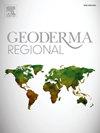利用土壤诊断特征和环境协变量来估计埃塞俄比亚土壤的养分含量
IF 3.3
2区 农林科学
Q2 SOIL SCIENCE
引用次数: 0
摘要
埃塞俄比亚的小农通常无法获得土壤测试服务,无法进行养分管理规划决策;因为土壤分析对大多数农民来说太昂贵了。肥料方面的建议通常可以通过国家范围内的一揽子建议获得。因此,需要一种替代方法来估计埃塞俄比亚不同景观的土壤养分含量。在本研究中,我们建议使用诊断特征来估计土壤养分含量,这可能有助于制定肥料建议。为实现这一目标,确定了以下目标:(i)估计受土壤诊断特征影响的土壤养分含量;(二)阐明环境协变量和诊断特征对埃塞俄比亚土壤养分水平估计的影响。来自分布在埃塞俄比亚各地的550个土壤剖面的数据是从一系列已发表的来源收集、整理和协调的。对数据进行了清理,并准备了496个土壤剖面进行建模。为了确定哪些诊断特征存在于这些土壤中,我们应用了存在/不存在评分方法来确定主要诊断特征。采用多元线性回归分析从诊断特征和诊断特征以及环境协变量对土壤化学性质进行预测。采用平均误差(ME)、林氏一致性相关系数(LCCC)、均方根误差(RMSE)和模型效率系数(MEC)进行10倍交叉验证,评价模型的性能。由诊断特征和环境协变量组合得出的pH、TN和CEC的MEC值分别为0.38、0.33和0.38。相应的RMSE值分别为0.78、0.07%和13 cmol kg−1。pH、TN和CEC的LCCC值分别为0.62、0.58和0.62。土壤化学性质的交叉验证结果表明,加入环境协变量后,模型的性能有所提高。降水、温度、地质和土地覆盖是估算埃塞俄比亚土壤养分含量最重要的环境协变量,同时也是埃塞俄比亚土壤的诊断特征。总之,诊断方法为估算土壤养分含量提供了一个有用的起点。然而,在六个诊断特征中,营养成分含量的变化没有充分量化,模型的预测性能仍然不足以在局部尺度上实际应用。需要进一步扩大数据集,以充分利用这些模型的潜力,为埃塞俄比亚和其他获得土壤测试信息有限的地区的养分管理决策提供基础。本文章由计算机程序翻译,如有差异,请以英文原文为准。
Utilising soil diagnostic features and environmental covariates to estimate nutrient content in Ethiopian soils
Smallholder farmers in Ethiopia generally do not have access to soil testing services for nutrient management planning decisions; as soil analysis is too costly for most farmers. Fertiliser advice is generally accessible via blanket recommendations at a national scale. Hence, an alternative approach is needed to estimate soil nutrient content across the diverse landscapes of Ethiopia. In this study, we propose using diagnostic features to estimate soil nutrient content, which could contribute to the development of fertiliser recommendations. To achieve this the following objectives were defined: (i) to estimate soil nutrient content as influenced by soil diagnostic features; and (ii) to elucidate the influence of environmental covariates and diagnostic features on the estimation of soil nutrient levels in the Ethiopian context. Data from 550 soil profiles, distributed across Ethiopia, were collected from a range of published sources, collated and harmonised. The data were cleaned, and 496 soil profiles were prepared for modelling. To identify which diagnostic characteristics were present across these soils we applied a presence/absence scoring method to identify dominant diagnostic features. Multiple linear regression analyses were used to predict soil chemical properties from the diagnostic features and diagnostic features along with environmental covariates. The performance of the models was evaluated by applying a 10-fold cross-validation using mean error (ME), Lin's concordance correlation coefficient (LCCC), root mean square error (RMSE) and model efficiency coefficient (MEC). The MEC values for pH, TN, and CEC derived from a combination of diagnostic features and environmental covariates were 0.38, 0.33, and 0.38. The corresponding RMSE values were 0.78, 0.07 %, and 13 cmol kg−1. Additionally, the LCCC values for pH, TN, and CEC were 0.62, 0.58, and 0.62, respectively. The cross-validation results for soil chemical properties showed that the model's performance improved when environmental covariates were added. Precipitation, temperature, geology and land cover were the most important environmental covariates for estimating nutrient content, along with diagnostic features of Ethiopian soils. In conclusion, the diagnostic approach offers a useful starting point for estimating soil nutrient content. However, the variation in nutrient content across the six diagnostic features was not adequately quantified, and the model's predictive performance remains insufficient for practical application at the local scale. Further expansion of the dataset is required to fully exploit the potential of these models for underpinning nutrient management decisions across Ethiopia and in other regions where access to soil test information is limited.
求助全文
通过发布文献求助,成功后即可免费获取论文全文。
去求助
来源期刊

Geoderma Regional
Agricultural and Biological Sciences-Soil Science
CiteScore
6.10
自引率
7.30%
发文量
122
审稿时长
76 days
期刊介绍:
Global issues require studies and solutions on national and regional levels. Geoderma Regional focuses on studies that increase understanding and advance our scientific knowledge of soils in all regions of the world. The journal embraces every aspect of soil science and welcomes reviews of regional progress.
 求助内容:
求助内容: 应助结果提醒方式:
应助结果提醒方式:


